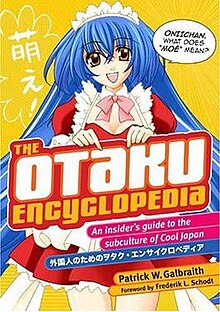
Otaku is a Japanese word that describes people with consuming interests, particularly in anime, manga, video games, or computers. Its contemporary use originated with a 1983 essay by Akio Nakamori in Manga Burikko. Otaku may be used as a pejorative, with its negativity stemming from a stereotypical view of otaku as social outcasts and the media's reporting on Tsutomu Miyazaki, "The Otaku Murderer", in 1989. According to studies published in 2013, the term has become less negative, and an increasing number of people now identify themselves as otaku, both in Japan and elsewhere. Out of 137,734 teens surveyed in Japan in 2013, 42.2% self-identified as a type of otaku.

A catgirl is a female kemonomimi character with feline traits, such as cat ears, a cat tail, or other feline characteristics on an otherwise human body. Catgirls are found in various fiction genres and in particular Japanese anime and manga. Catboy is a term for a male equivalent of said character type.

In Japanese popular culture, lolicon is a genre of fictional media in which young girl characters appear in romantic or sexual contexts. The term also refers to desire and affection for such characters, and fans of such characters and works. Associated with unrealistic and stylized imagery within manga, anime, and video games, lolicon in otaku culture is understood as distinct from desires for realistic depictions of girls, or real girls as such, and is associated with the concept of moe, or feelings of affection and love for fictional characters as such.

In Japanese popular culture, a bishōjo, also romanized as bishojo or bishoujo, is a cute girl character. Bishōjo characters appear ubiquitously in media including manga, anime, and computer games, and also appear in advertising and as mascots, such as for maid cafés. An attraction towards bishōjo characters is a key concept in otaku subculture.

Rei Ayanami is a fictional character from the Neon Genesis Evangelion franchise, created by Gainax studio. In the anime series of the same name, Rei is an introverted girl chosen as the pilot of a giant mecha named Evangelion Unit 00. At the beginning of the series, Rei is an enigmatic figure whose unusual behavior astonishes her peers. As the series progresses, she becomes more involved with the people around her, particularly her classmate and fellow Eva pilot, Shinji Ikari. Rei appears in the franchise's animated feature films and related media, video games, the original net animation Petit Eva: Evangelion@School, the Rebuild of Evangelion films, and the manga adaptation by Yoshiyuki Sadamoto.
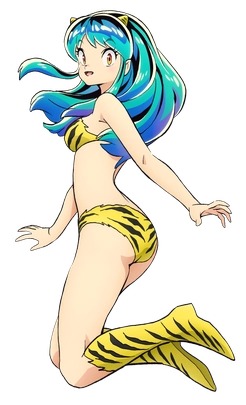
Lum the Invader Girl, known in Japan simply as Lum, is a fictional character and the female protagonist of Rumiko Takahashi's manga series Urusei Yatsura. She is often believed to be the main protagonist of the series due to her iconic status. However, Takahashi has stated that Ataru Moroboshi is the main character.
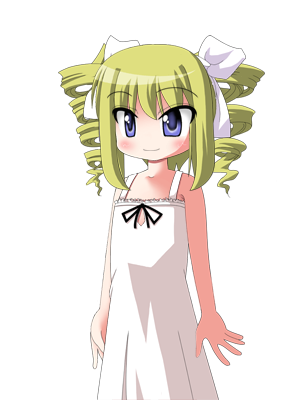
Moe, sometimes romanized as moé, is a Japanese word that refers to feelings of strong affection mainly towards characters in anime, manga, video games, and other media directed at the otaku market. Moe, however, has also gained usage to refer to feelings of affection towards any subject.

Densha Otoko is a Japanese movie, television series, manga, novel, and other media, all based on the purportedly true story of a 23-year-old otaku who intervened when a drunk man started to harass several women on a train. The otaku ultimately began dating one of the women.

Tsundere is a Japanese term for a character development process that depicts a character with an initially harsh personality who gradually reveals a warmer, friendlier side over time.
The following is a glossary of terms that are specific to anime and manga. Anime includes animated series, films and videos, while manga includes graphic novels, drawings and related artwork.
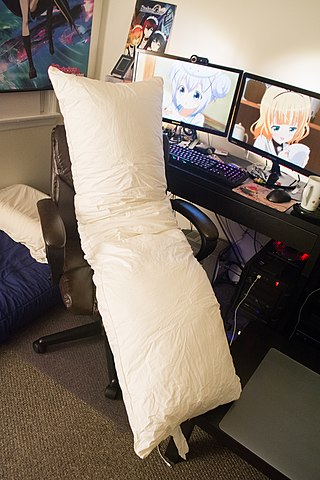
A dakimakura is a type of large pillow from Japan which are usually coupled with pillow covers depicting anime characters. The word is often translated to English as body pillow, waifu pillow, or husbando pillow. In Japan, dakimakura are similar to Western orthopedic body pillows, and are commonly used by Japanese youth as "comfort objects".

Akiba-kei or Akiba-chan (アキバちゃん) is a Japanese slang term for Akihabara style. Akihabara is a district in Chiyoda, Tokyo where many otaku—or obsessive anime, manga, idol, and video game fans—gather.

Lucky Star is a Japanese four-panel comic strip manga series by Kagami Yoshimizu. It has been serialized in Kadokawa Shoten's Comptiq magazine since December 2003. Cameo strips were published in other magazines such as Shōnen Ace and others. It has no ongoing plot and typically focuses on the daily lives of the characters.
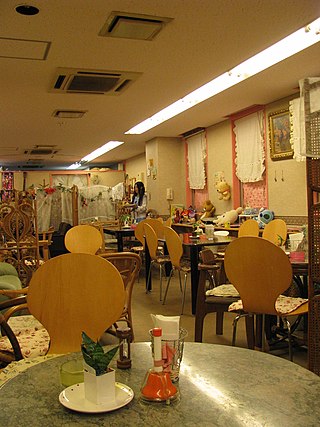
Maid cafés are a subcategory of cosplay restaurants found predominantly in Taiwan and Japan In these cafés, waitresses, dressed in maid costumes, act as servants, and treat customers as masters as if they were in a private home, rather than as café patrons. The first permanent maid café, Cure Maid Café, was established in Akihabara, Tokyo, Japan, in March 2001, but maid cafés are becoming increasingly popular. The increased competition drove the cafes to employ more diversified themes, gimmicks and even unusual tactics to attract customers. They have also expanded overseas to several countries around the world.
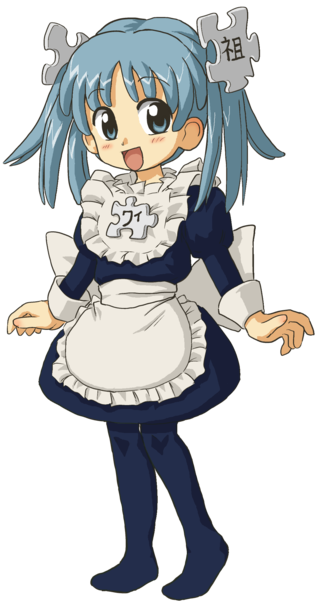
Moe anthropomorphism is a form of anthropomorphism in anime, manga, and game where moe qualities are given to non-human beings, objects, concepts, or phenomena. In addition to moe features, moe anthropomorphs are also characterized by their accessories, which serve to emphasize their original forms before anthropomorphosis. The characters here, usually in a kind of cosplay, are drawn to represent an inanimate object or popular consumer product. Part of the humor of this personification comes from the personality ascribed to the character and the sheer arbitrariness of characterizing a variety of machines, objects, and even physical places as cute.

The yaoi fandom consists of the readers of yaoi, a genre of male homosexual narratives. Individuals in the yaoi fandom may attend conventions, maintain/post to fansites, create fanfiction/fanart, etc. In the mid-1990s, estimates of the size of the Japanese yaoi fandom were at 100,000–500,000 people. Despite increased knowledge of the genre among the general public, readership remains limited in 2008. English-language fan translations of From Eroica with Love circulated through the slash fiction community in the 1980s, forging a link between slash fiction fandom and yaoi fandom.
Chica Umino is the pen name of a pseudonymous Japanese manga artist, designer and illustrator.
The anime and manga fandom is a worldwide community of fans of anime and manga. Anime includes animated series, films and videos, while manga includes manga, graphic novels, drawings, and related artworks. The anime and manga fandom traces back to the 1970s, with numerous countries such as the United States,United Kingdom, France, Italy, Spain, Germany, Japan, China, and Malaysia participating in it.

Fan service, fanservice or service cut, is material in a work of fiction or in a fictional series that is intentionally added to please the audience, often sexual in nature, such as nudity. The term originated in Japanese in the anime and manga fandom, but has been used in other languages and media. It is about "servicing" the fan – giving the fans "exactly what they want". Fan service can also refer to other stories that contain visual elements.

Manga Dogs, known in Japan as GDGD-DOGS, is a shōjo manga series by Ema Tōyama. The story follows Kanna, a fifteen-year-old manga artist who, already published as a pro joins her school's new manga course. Trying to finish her deadlines for her ongoing running manga series, she meets three boys who ask her to teach them Manga and have delusions of their own about being manga artists. The series was serialized in the shōjo manga magazine Aria (magazine), and has been released in North America by Kodansha USA. Overall, the series has received mixed reviews but made the New York Times best seller list for the week of October 5-11, 2014.
